Olivia Peace suspected that “Tachrichim,” the title that Jess Zeidman had originally given her comedy set at a synagogue – and not any old synagogue, but Temple Beth El, which the screenwriter had attended herself growing up in Rochester, New York — might be a mouthful for audiences, knowing from the experience of titling their own recent short, “Pangaea,” that it could be a deterrent.
“Watching people try to spell that and find it, just gave me all the information I needed to know,” laughed Peace, deciding to turn to their roommate Ethan, also with strong ties to Judaism, for help.
“Over the course of making this film, his grandfather had died and he went to that funeral and he brought back ‘Tahara,’” said Peace, who was moved by learning of the tradition of purifying the deceased and could appreciate how the term for it could easily roll off the tongue. “I thought it fit perfectly with the themes and I liked that it was teaching people a new word and it would feel familiar to our audience.”
If Peace takes great care with their words in framing of their debut, you should see what the director does with a camera in the bittersweet dramedy that unfolds over the course of a day at a Jewish prep school where best friends Carrie (Madeline Grey DeFreece) and Hannah (Rachel Sennott) die a hundred little deaths as they sit in mourning of a far bigger one when a classmate named Samantha has taken her own life. Neither knew the dearly departed all that well, making a situation that would be difficult to process on its own all the much harder for the teens who are already anxious about their future, but a further complication is thrown in when Hannah asks Carrie if she could try out her kissing skills on her before making a move on Tristan (Daniel Taveras), an upperclassman she’s had her eye on.
The smooch changes everything for the duo, but before that even happens, you sense you’re in the presence of a game changer in Peace, who fuses together a number of different formal ideas from various kinds of animation to a shifting aspect ratio, primarily set inside a square frame, to deliver something as revelatory as its characters feel, or at least Carrie, who comes to realize she wants to be more than friends with Hannah. Meticulous in its evocation of the pair’s conservative surroundings where there’s restlessness stirring in every corner, “Tahara” is just as precise in getting under the skin of its two leads, adventurous and untethered in giving shape to emotions that the pair works through when they can’t yet entirely comprehend them. While there may be no exact words to express what they’re feeling, Peace, Zeidman and a talented cast finds enthralling alternatives and “Tahara” grows into something far larger than its brisk 70-minute runtime would suggest.
Following its premiere at Slamdance, the film is rolling out into theaters and Peace graciously took the time to talk about putting such a distinctive debut together, the collaborative spirit that brought the best out of everyone and turning what could be for many a foreign experience into a deeply personal one.
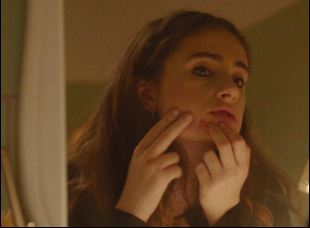
It’s been a long road with this film, but I had made a short that made it to the Sundance Ignite Fellowship a while back and that may have been how Jess [Zeidman, the screenwriter] heard of me because we actually both went to Northwestern at different times. At some point, she messaged me on Facebook about having a script that I might be interested in directing and I was intending really politely to turn her down because I was already working on a project. [laughs] But then I read it and the pimple popping scene was what sold me, particularly because I had a really clear vision of how that needed to look, how ostensibly how Jess needed to direct this, but really what fully sold me on the film was talking to Jess. We had this really long conversation about all these ideas that had come to me once I had read the script. I think every single thing I brought up on that call, I was sure she was going to say no to. [laughs] It wasn’t just one wacky idea, it was many. From the casting to adding animation, which was not in the script, to having this square frame and she was so open to all of them and excited. And this film seemed like something that could be made really quickly and really well and with a lot of support behind it and a lot of familiar faces.
You have a real variety of interests as an artist – your background is in animation and you’ve been studying interactive and VR. Was a straightforward feature actually exciting creatively or was it enough of a challenge?
For me, the challenge was there just because a feature was something I hadn’t done before, and leading up to the shoot, I started feeling quite nervous. I had this one mentor I had asked for advice on how to go from making shorts to making a feature and pretty much all the advice I had gotten to that point was, “It’s exactly the same thing. You know what to do. Follow your heart.” [But this person] was like, “You need to train like a professional athlete.This is going to be really taxing on your mind, your body and on your emotions.” [laughs] I really took that quite seriously and I actually picked up a yoga practice along the way and quit coffee at that time and started matcha — all these things to make sure I was up to par to direct this.
Luckily, there were a number of things that helped me transition into directing this particular film, which I got to make with a lot of my friends. Ashley Mills was our first AC and she actually shot our short that went to the Sundance Ignite program. Troy Lewis was our editor and that was a huge because he came on set to literally live edit the film as we were shooting, so that I could be sure that by the time we left, we had a film. [laughs] All these people came at a drop of a hat to be there and support me, and the challenge was definitely there, but it also helped being in one location that Jess intended for the script to be from. That was her actual childhood synagogue, so a lot of the scenes were directly pulled from her memories and a lot of the people she was referring to as we were talking about the script were still there. So it was just enough of a challenge and I love that. When I’m thinking about my art, I’m always looking for something where I can learn a lot, but I know just enough for it not to go horribly awry.
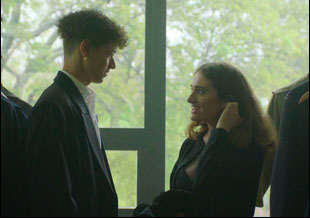
Because I had gotten quite nervous, I was like, “I need to prepare as much as possible” and part of that was I had storyboarded the film by myself and the cinematographer Tehillah [De Castro], our cinematographer who is fully a genius, and I had gone through these storyboards and came out with these really clear and concise plans about how we would shoot this. Then we got there and it all went out the window. [laughs] A month before the shoot, we went out for a location scout so that we could see the synagogue and also so I could see Rochester — that was important to me because that was the larger setting of this and it should inform the film. Once I saw everything in person, we realized most of the things we had planned were not going to work. That first kiss scene where the camera swirls around the two and it transitions into Claymation, I wanted that to initially be on a 360° dolly track that you could push, but the space is super small, so we got the dolly in that day and it literally wouldn’t even fit through the door. And this was almost everyone’s first feature film, except for Madeline, who had shot a feature a little bit prior, and this was what Brene Brown calls an FFT or a “first f’n time.” But it was really handled with grace. Generally, I really leaned on Jess when I think it came to specific cultural elements and I think she then was able to lean on me and trust me when it came to trying to push the direction of the film to be something a bit more experimental while still being fun and accessible for people.
Part of that is actually how the film is cast – was the diversity of the school something that was always there?
That was something we talked about in the very first call. I said [to Jess], “I direct films about Black people. How do you feel about one of the leads being a black person?” And that came from my background. I went to this Christian religious school in West Bloomfield, Michigan, so when I read the script I really related to it, down to even how the ladies’ lounge looked — in my home church growing up, we had that room with the floral couch where people would go and hide out and yeah, try to get away from Sunday school. Michigan has a large and really diverse Jewish community [as well], and in films, Judaism has been portrayed in a really particular way or with a particular look, but that was just not my reality growing up, so if I was ever going to direct a film, that was not going to be the reality of this film. Jess loved that — she has some people in her family who are of different races — and she was like, “Yeah, I think that would mean a lot to a lot of people to see that,” so when we went to cast for both roles, we did open casting, [particularly] for Carrie’s role because I think I related to Carrie the most. We got some really, really amazing actors for both roles and I’m really grateful for who we landed in the end.
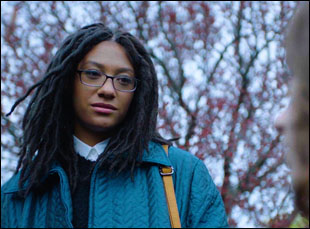
They’re both great talents. We did Zoom casting before that was cool, in 2019 before everything went awry, and both of them were good, but then when they came in person, what I really loved about both of them was they were extremely interested in learning and in showing a lot of variation between different takes. Part of the casting was just asking them questions about the character without them acting to just see if they would be able to relate to the characters. I really loved Madeline’s answers to the questions and I ended up pulling on that when we were then on set, and Rachel comes from a standup comedy background, so we were able to pull from that where she was literally on set, writing some jokes and then Madeline just has a real well of emotion. She’s classically trained, so we would get a lot of variation from her. I would always do this thing where I would get the takes that I wanted of specific looks and I would always do one where I’d tell her to do what she felt was best. Almost across the board, what she felt was best was what we’d put in the film in the end.
Something that surprised me was hearing the square frame didn’t actually emerge because it could be used as a metaphor for isolation, though it works so well that way. How did you come to embrace that aspect ratio?
Generally, I had never seen a square film before, so I no idea how it would work or what it would do and that’s what I’m talking about where I really just love learning. That’s why I love directing and I love working with people as we all learn something together. That probably made the producers nervous. [laughs] So we tried this thing where my frame would be the 1:1 aspect ratio, and just as a fail-safe, we still had a 4:3 clearance, so like if this didn’t work out, we could go back to a somewhat regular frame. But I got it from Instagram [because] video was starting to become a bit more popular, not to the point where they have reels [now], but I was feeling like there was a lot of potential there to show a more complicated story that’s over a minute long in that same aspect ratio that a lot of teens are really familiar with, and when I went out to interview cinematographers, pretty much no one was excited about that, except for Tehillah, who is my great friend and a really amazing talent.
At the time, I hadn’t realized that she just graduated from college and though this is her first feature, she came to me with all these amazing references. She introduced me to all these different arthouse films and one of them was Xavier Dolan’s “Mommy,” and I’d already started storyboarding this in the 1:1 aspect ratio, I had already tested and talked about extending the frame [at certain points], but I didn’t have any idea that any of these things were going to work. My producers were not sold on this, but [it was Tehillah] bringing that reference where I saw not only can this work, but it can be the right choice for this movie — to pick a frame that’s small, so that when you’re with the character, you feel really with them. You do feel the isolation, alienation and anxiety when you can only fit one-and-a-half people in a frame because any single shot you have no idea how everyone else in the room is reacting. But it was one of those things, whether it was having my friends on set or shooting in one location where because the frame was so small, I could really carefully organize everything in the frame to make every single shot feel deliberate. The frame is like two steps wide. It’s a lot easier to orchestrate in that way and to block everyone around.
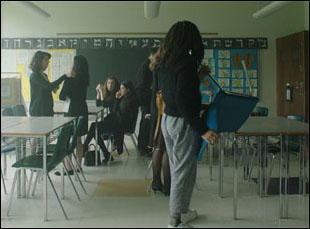
Oh fully, and you know what? I went back to those original storyboards and we found them all again in the edit, even when they’re forgotten on set, which was really amazing. Troy’s an incredible, incredible editor and just a sweet person where no matter how ridiculous the idea is, he will try it to the best of his ability, sometimes to show you it won’t work. He wouldn’t say it like that, but at some point, there was a while where I played around with recording songs for the film, like little theme songs for Tristan and Hannah with my own voice – I cannot sing, [so I’m thinking] why did Troy let me do this? He sat there as I recorded this in my closet and like brought it back out and put it in the film and we laughed and laughed and he just quietly deleted it. [laughs] There are many things like that. Generally he helped with that pace where it stays really tight and no shot or scene is wasted and you really feel like you’ve really watched an entire day go by at the end of it. It really feels this has happened true to life in real time. The walk at the very end where we had Rachel walk all the way home so you have to see her cross the whole parking lot, he really believed in that and helped me when it came to explaining to the producers why we should keep that in before the credits. That’s one of my favorite things about the film is that walk at the end.
Another really distinctive aspect of the film is how you incorporate animation. What was it like to work with Emily Ann Hoffman?
It was really cool. From the beginning, I wanted to have animation in the film and though I am an animator, I wanted for this film to be my first time that I worked with another animator because on all of my previous work I would direct and do all the animation myself by hand. Working with Emily was really cool in that I wanted different styles for the different lead roles, so for Carrie, when we were entering her imagination, I told her I wanted something that was really dimensional, which is how we landed on the clay puppets. For Hannah, I wanted something flat that seems a bit warped, so that’s how we got that woozy, psychedelic rotoscoping. [Emily] was actually in that Sundance Ignite program with me, so I knew she had a huge range when it came to animation where she could do stop-motion puppetry, but she also had a bunch of different drawing styles so it was just a perfect match. She understood the story so well and really loved the script, so it was a really cool collaboration that came from the two of us. Some of her animation didn’t make it in, and [now] I’m trying to see if there’s a way we can use it for something else because it’s so good. There’s another cut of the film that had Samantha, the girl who passed away as a ghost throughout, and Emily made these ghosts and Troy came on and said, “We’ve got to get rid of these ghosts.” [laughs]
When this takes off, as I know this is going to, you’re going to have to put that out as a prequel.
“Samantha’s Ghost,” the short! [laughs]
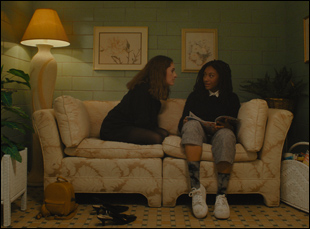
Absolutely, and again, I was incredibly nervous when I came into “Tahara,” but having my community come around me and help me out on this film — all my friends have seen an absurd amount of cuts of this movie and have given amazing feedback that’s part of what we’re all seeing today, so I think everything that I make going forward, I really have it in mind to be a community affair. That’s part of what my production company/filmmaking collective called the Indefinite Village is. I really love and respect being referred to as an auteur, which I think is very sweet and it definitely makes my ego happy, but the truth of filmmaking is always that though there usually is one director, there’s this huge sea of people that the vision is being pulled from artistically and that have had hands in the literal making the film. That’s the village and when it comes to my next feature, I think it’s going to be a lot of familiar faces.
Even when it came to my thesis project at USC, I made a film with AI, which is its own lofty thing, but it was my neighbor who gave me the subject matter to talk about. We were talking about lucid dreaming is and my friend’s uncle helped me build an installation for it. [laughs] So I love that because yes, it’s important to have really good films and great stories with important themes, but it’s also important to be building with community, raising people’s self-esteem to see what they’re capable of as artists in their own right. That’s what I try to do as a director.
“Tahara” opens on June 10th in New York at the Quad Cinemas and Los Angeles on June 17th at the Encino Town Center 5 and the Laemmle Royal before expanding across the country. A full list of theaters and dates is here.




